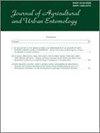文章标题哥伦比亚隐蝇和隐蝇首次记录(鞘翅目:隐蝇科)
Q2 Agricultural and Biological Sciences
The Journal of Agricultural and Urban Entomology
Pub Date : 2022-10-10
DOI:10.3954/1523-5475-38.1.16
引用次数: 0
摘要
隐翅目(鞘翅目:宽翅目)包括至少15种经济上重要的害虫(Chen等人,2020)。这些害虫被认为是次生害虫,因为只有在果皮受损的情况下,幼虫才能穿透谷物(Treaterra&Throne,2012年)。Cryptolestes ferrogineus(Stephens)(锈粒甲虫)、C.pusilulus(Schönherr)(扁粒甲虫)和C.pusiloides(Steel&Howe)是世界上最常报告的物种(Thomas,2002年)。成虫呈红褐色,体长约2毫米(Mason 2003)。每只雌性产100至400个蛋,可能在大约23天内发育成成虫(Treaterra&Throne,2012年)。在不利的条件下,如在粮食短缺期间,种群主要通过消耗自己的卵、蛹和蛹来生存(Lefkovitch 1962,Mason 2019)。成虫飞行能力强,可以在粮食储存设施内和周围传播(Holloway等人,2018)。Cryptolestes spp.的分布在世界范围内不断扩大。Halstead(1993)报道了C.ferrogineus是一个世界性物种,而C.pusilus和C.pusiloides的地理范围更为有限。如今,所有这些物种都具有世界性分布(图1),并已在花生、咖啡、大麦、大米、高粱、可可豆、小麦、玉米和储存的干加工产品的储存谷物中发现(Hagstrum等人,2013,CABI 2022)。Tróchez(1987)报告称,哥伦比亚储存的谷物中存在许多隐脂菌属标本,但没有确定任何特定物种。哥伦比亚农业研究所(ICA)还报告称,2018年2月7日至2019年5月14日期间,从秘鲁运来的六批生咖啡豆和2018年1月19日从厄瓜多尔运来的一批青咖啡豆中截获了脓疱梭菌(Anadex 2019)。如今,隐脂蛋白在哥伦比亚的存在和物种多样性在很大程度上仍然未知。本研究的目的是确定在哥伦比亚储存的谷物中是否存在经济上重要的隐脂虫物种。我们在哥伦比亚首次报道了C.pusilus和C.pusiloides。2021年7月至12月,在全国各地的不同粮食储存设施中人工采集了样本。Cryptolestes spp.的大小和外部形态特征相似。为了正确鉴定该物种,本文章由计算机程序翻译,如有差异,请以英文原文为准。
First Record of Cryptolestes pusillus and Cryptolestes pusilloides (Coleoptera: Laemophloeidae) in Colombia
Cryptolestes (Coleoptera: Laemophloeidae) includes at least 15 economically important pest species (Chen et al. 2020). These are considered secondary pests because the larvae can penetrate the grain only if the pericarp is damaged (Trematerra & Throne 2012).Cryptolestes ferrugineus (Stephens) (the rusty grain beetle), C. pusillus (Schönherr) (the flat grain beetle) and C. pusilloides (Steel & Howe) are the most frequently reported species worldwide (Thomas 2002). Adults are reddish brown and about 2 mm in length (Mason 2003). Each female lays 100 to 400 eggs and may develop into adults in approximately 23 d (Trematerra & Throne 2012). In adverse conditions, such during a food shortage, population survives the mainly by consuming their own eggs, pupae and prepupae (Lefkovitch 1962,Mason 2019). Adults are strong fliers, allowing their dispersal in and around grain storage facilities (Holloway et al. 2018). Distribution of Cryptolestes spp. has been expanding worldwide. Halstead (1993) reported that C. ferrugineus is a cosmopolitan specie, whereas C. pusillus and C. pusilloides have more restricted geographic ranges. Today, all of these species have a cosmopolitan distribution (Figure 1) and have been reported in stored grains of peanut, coffee, barley, rice, sorghum, cocoa beans, wheat, corn and stored dry processed products (Hagstrum et al. 2013, CABI 2022). Tróchez (1987) reported the presence of a number of specimens of Cryptolestes spp. in stored grains in Colombia but did not identify any particular species. The Colombian Institute of Agriculture (ICA) also reported interceptions of C. pusilloides in six shipments of green coffee beans from Peru between 7 February 2018 and 14 May 2019 and one from Ecuador on 19 January 2018 (Analdex 2019). Today, the presence and species diversity of Cryptolestes in Colombia are still largely unknown. The objective of this study was to determine the actual presence of economically important species of Cryptolestes spp. in stored grains in Colombia. We report C. pusillus and C. pusilloides for the first time in Colombia. Specimens were manually collected between July and December 2021 in different grain storage facilities around the country. The size and external morphological characteristics are similar among Cryptolestes spp. To properly identify the species,
求助全文
通过发布文献求助,成功后即可免费获取论文全文。
去求助
来源期刊

The Journal of Agricultural and Urban Entomology
Agricultural and Biological Sciences-Insect Science
CiteScore
1.40
自引率
0.00%
发文量
2
期刊介绍:
The Journal of Agricultural and Urban Entomology (JAUE) (Journal of Agricultural Entomology, Jan 1984 - Oct 1998 volumes 1-15) is published under the auspices of the South Carolina Entomological Society (SCES). The Journal publishes contributions of original research concerning insects and other arthropods of agricultural and urban importance to include those affecting humans, livestock, poultry, and wildlife. JAUE is particularly dedicated to the publication of articles and notes pertaining to applied entomology, although it will accept suitable contributions of a fundamental nature related to agricultural and urban entomology.
 求助内容:
求助内容: 应助结果提醒方式:
应助结果提醒方式:


